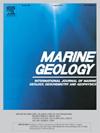Mid to late Holocene Indian monsoon variability, aridification and civilization changes in the Deccan Plateau, India
IF 2.6
3区 地球科学
Q2 GEOSCIENCES, MULTIDISCIPLINARY
引用次数: 0
Abstract
Climate change has been a key driver throughout human history and has frequently been associated with the rise and fall of civilizations. Holocene settlement changes or population displacements were almost always preceded by changes in climate. A high-resolution sedimentary record from the western Bay of Bengal offers insights to centennial-scale mid- to late-Holocene Indian summer monsoon (ISM) variability and its role in the decline of chalcolithic human settlements on India's Deccan Plateau. Increased erosion in the Indian peninsula during the mid- to late-Holocene, due to aridification and agricultural expansion, is evidenced by higher sedimentation, more magnetic mineral content, coarser magnetic grain size, and increased sand content. The results from mineral magnetic and textural analyses reveal centennial-scale abrupt weak ISM during the Bond events in the core monsoon zone of India. The Deccan Chalcolithic civilizations flourished between ∼4.0–3.0 ka BP owing to the favorable climatic conditions, but most of the settlements were deserted after ∼3.0 ka BP. We argue that the abrupt weakening of ISM during Bond event 2 (∼3.1–2.8 ka BP) caused this collapse of Deccan Chalcolithic. The results from this study together with the published records of number of settlements and summed radiocarbon dates suggest a climate-culture link in the Deccan Plateau. The weak ISM periods in this study are coherent with the records of total solar irradiance and the percentage of hematite-stained grains from the North Atlantic and suggest solar control on these abrupt climatic events.
印度德干高原全新世中期至晚期的印度季风变异、干旱化和文明变迁
气候变化是整个人类历史的关键驱动因素,并经常与文明的兴衰联系在一起。全新世的定居变化或人口迁移几乎总是先于气候变化。来自孟加拉湾西部的高分辨率沉积记录为了解全新世中期至晚期百年尺度的印度夏季季风(ISM)变异及其在印度德干高原旧石器时代人类定居点衰落过程中的作用提供了线索。在全新世中期至晚期,由于干旱化和农业扩张,印度半岛的侵蚀加剧,这表现为沉积物增多、磁性矿物含量增加、磁性粒度变粗以及含沙量增加。矿物磁性和纹理分析的结果显示,在印度核心季风区的邦德事件期间,突然出现了百年规模的弱 ISM。由于有利的气候条件,德干旧石器时代文明在公元前 4.0 至 3.0 千年之间蓬勃发展,但在公元前 3.0 千年之后,大部分聚落被遗弃。我们认为,在邦德事件 2(∼3.1-2.8 ka BP)期间,ISM 的突然减弱导致了德干巨石时代的崩溃。这项研究的结果与已公布的聚落数量记录和放射性碳年代总和一起,表明了德干高原气候与文化之间的联系。这项研究中的弱ISM时期与太阳总辐照度记录和北大西洋赤铁矿染色颗粒的百分比相一致,表明太阳控制了这些突变的气候事件。
本文章由计算机程序翻译,如有差异,请以英文原文为准。
求助全文
约1分钟内获得全文
求助全文
来源期刊

Marine Geology
地学-地球科学综合
CiteScore
6.10
自引率
6.90%
发文量
175
审稿时长
21.9 weeks
期刊介绍:
Marine Geology is the premier international journal on marine geological processes in the broadest sense. We seek papers that are comprehensive, interdisciplinary and synthetic that will be lasting contributions to the field. Although most papers are based on regional studies, they must demonstrate new findings of international significance. We accept papers on subjects as diverse as seafloor hydrothermal systems, beach dynamics, early diagenesis, microbiological studies in sediments, palaeoclimate studies and geophysical studies of the seabed. We encourage papers that address emerging new fields, for example the influence of anthropogenic processes on coastal/marine geology and coastal/marine geoarchaeology. We insist that the papers are concerned with the marine realm and that they deal with geology: with rocks, sediments, and physical and chemical processes affecting them. Papers should address scientific hypotheses: highly descriptive data compilations or papers that deal only with marine management and risk assessment should be submitted to other journals. Papers on laboratory or modelling studies must demonstrate direct relevance to marine processes or deposits. The primary criteria for acceptance of papers is that the science is of high quality, novel, significant, and of broad international interest.
 求助内容:
求助内容: 应助结果提醒方式:
应助结果提醒方式:


